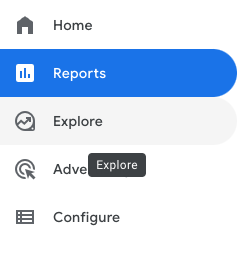Tutorial 4: Using Google Analytics
Getting Started¶
We equip every chapter site with its own Google Analytics tracking stream at launch! This is a helpful tool to allow for greater clarity on how users access your site and interact with content.
Note: If your chapter already has Google Analytics setup we are happy to set up a stream from that account onto the new site. We will need to be given viewer access to the account and the gtag for the respective stream. Let us know at launch if this applies to you!
Connecting a non-Gmail account to Google¶
To ensure proper access to your Google Analytics account you will need to connect your point-of-contact email address to Gmail. If your current email is not yet connected to Gmail, doing so is a relatively simple process.
- Go to the Google Account Sign In page.
- Click Create account.
- Enter your name.
- Click Use my current email address instead.
- Enter your current email address.
- Click Next.
- Verify your email address with the code sent to your existing email.
- Click Verify.
Leveraging Google Analytics for Content Development¶
At a high level, Google Analytics can be used to track basic engagement such as visitor amount and country access. Your site has been optimized to draw in visitors and help them find valuable information easily.
A helpful metric to use in adjusting site content within the framework is the Reports tab. This section will allow for granular reports that will display how users arrived on your site, how long they spent on certain pages, and even what devices they're using.

This information can then help you make more informed decisions on adjusting your content. Ask yourself questions like:
- Why are guests consistently leaving the site at a specific spot?
- What media would work better for my mobile guests?
- Is the content I'm providing valuable to our key audience?
What Is GA4 and Why It Matters¶
GA4 is the fourth iteration of Google Analytics (hence GA4), replacing Universal Analytics (UA).GA4 has shifted away from UA in a big way - mostly around how it handles insights about user behavior and engagement. This tool can help you understand how people are finding your website and what people are doing on it.
GA4 Basics: Key Metrics to Understand¶
- Users & Sessions: Who’s visiting and how often
-
- Users: Individual people on your site
- Sessions: When a user views a page and no current session is active (or a previous session times out - 30 minutes)
- Engagement Rate: Replaced bounce rate - measures meaningful interactions
-
-
An Engagement will hit when a user does any one of these 3 actions
-
Lasts longer than 10 seconds
- Has a key event
- Has 2 or more screen or page views
- Traffic Sources: Where visitors are coming from (social, search, direct, etc.)
- Event Tracking: Actions users take (button clicks, video views, form submissions)
- Conversions: Define key events (newsletter signups, contact form submissions, donations, etc)
-
GA4 Reports: How to Learn From the Metrics¶
- Reports Snapshot: High level overview of what’s been happening
- Real-Time Report: See active users and live traffic
- Acquisition Report: Understand how people are getting to your site
-
Audience Insights: Demographics and its limitations
-
Need to enable Google Signals (walk through this) under “data collection”
- It will only capture demographic data if the user is logged into their Google account and has ad personalization turned on
- Explore Reports: Customizable reports for you to dive deeper into your data discovery
Quick Wins for Chapter Leaders¶
-
Use UTM tracking for social, referral, and email links to increase accuracy of traffic source tracking
- Use the Acquisition Report to see whether people find your site via social media, Google searches, referrals, or direct traffic. This helps you understand what’s working and where to focus/scale your efforts
-
Play around with explore reports to see what you can learn - and where some data gaps might be.
-
This can help you identify what additional custom events or key events would be worth setting up - the set up of this can be a little more advanced. But the more you understand, the better chance you have of learning new things or finding someone who knows how to do this.
Further Learning¶
Whether you're a pro, new to Google Analytics, or unfamiliar with the new GA4 version being implemented; Google has provided resources to help you brush up on your skills.